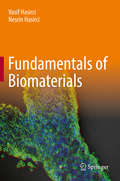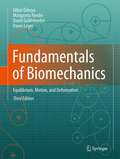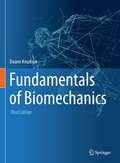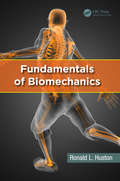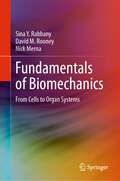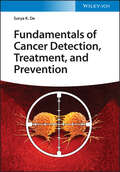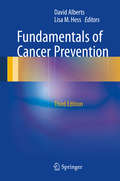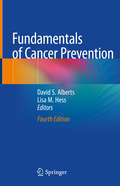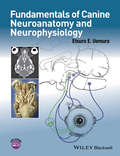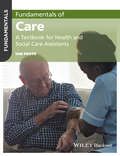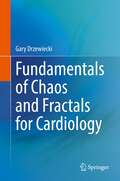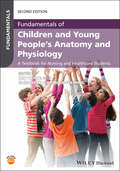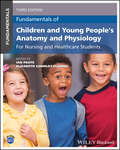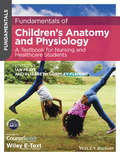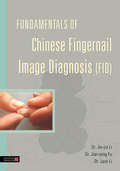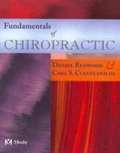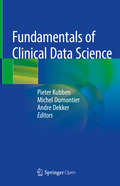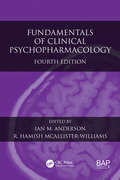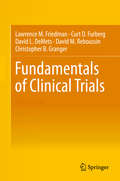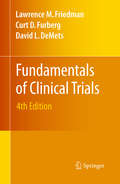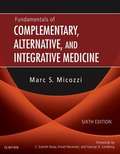- Table View
- List View
Fundamentals of Biomaterials: An Introduction
by Vasif Hasirci Nesrin HasirciThis text for advanced undergraduate and graduate students covers the fundamental relationships between the structure and properties of materials and biological tissues. The successful integration of material and biological properties, shape, and architecture to engineer a wide range of optimized designs for specific functions is the ultimate aim of a biomaterials scientist. Relevant examples illustrate the intrinsic and tailored properties of metal, ceramic, polymeric, carbon-derived, composite, and naturally derived biomaterials.Fundamentals of Biomaterials is written in a single voice, ensuring clarity and continuity of the text and content. As a result, the reader will be gradually familiarized with the field, starting with materials and their properties and eventually leading to critical interactions with the host environment. Classical and novel examples illuminate topics from basic material properties to tissue engineering, nanobiomaterials, and guided tissue regeneration.This comprehensive and engaging text:integrates materials and biological properties to understand biomaterials function and designprovides the basics of biological tissue components and hierarchyincludes recent topics from tissue engineering and guided tissue regeneration to nanoarchitecture of biomaterials and their surfacescontains perspectives/case studies from widely-recognized experts in the fieldfeatures chapter-ending summaries to help readers to identify the key, take-home messages.
Fundamentals of Biomechanics
by Margareta Nordin David Goldsheyder Dawn Leger Nihat ÖzkayaBiomechanics applies the principles and rigor of engineering to the mechanical properties of living systems. This book integrates the classic fields of mechanics--statics, dynamics, and strength of materials--using examples from biology and medicine. Fundamentals of Biomechanics is excellent for teaching either undergraduates in biomedical engineering programs or health care professionals studying biomechanics at the graduate level. Extensively revised from a successful first edition, the book features a wealth of clear illustrations, numerous worked examples, and many problem sets. The book provides the quantitative perspective missing from more descriptive texts, without requiring an advanced background in mathematics. It will be welcomed for use in courses such as biomechanics and orthopedics, rehabilitation and industrial engineering, and occupational or sports medicine.
Fundamentals of Biomechanics
by Duane KnudsonBlending up-to-date biomechanical knowledge with professional application knowledge, this second edition presents a clear, conceptual approach to understanding biomechanics within the context of the qualitative analysis of human movement. It develops nine principles of biomechanics, which provide an applied structure for biomechanical concepts, and the application of each principle is fully explored in several chapters. The book also offers real-world examples of the application of biomechanics, which emphasize how biomechanics is integrated with the other subdisciplines of kinesiology to contribute to qualitative analysis of human movement.
Fundamentals of Biomechanics
by Ronald L. HustonIn the last three or four decades, studies of biomechanics have expanded from simple topical applications of elementary mechanics to entire areas of study. Studies and research in biomechanics now exceed those in basic mechanics itself, underlining the continuing and increasing importance of this area of study. With an emphasis on biodynamic modeli
Fundamentals of Biomechanics: From Cells to Organ Systems
by Sina Y. Rabbany David M. Rooney Nick MernaFundamentals of Biomechanics: From Cells to Organ Systems combines biology with engineering to provide a comprehensive overview of biomechanics. It covers cell, tissue, and fluid mechanics in a way that is easy to understand, requiring only a basic background in biology and mechanics. The book includes a wide range of topics, from single-cell mechanics to forces in the musculoskeletal system. Each chapter provides an introduction to biological systems, along with examples and practice problems throughout the text. The book also offers step-by-step derivation of equations from principles. This textbook has been classroom-tested and is designed for advanced undergraduate engineering courses in bioengineering, biomechanics, and physiology. It is also a valuable reference for graduate students, practicing engineers, and medical professionals. Integrates biology with engineering; Includes examples and practice problems throughout the text; Requires a limited background in biology and mechanics.
Fundamentals of Cancer Detection, Treatment, and Prevention
by Surya K. DeFundamentals of Cancer Detection, Treatment, and Prevention The professional guide to cancer diagnosis and therapy for researchers and clinicians In Fundamentals of Cancer Detection, Treatment, and Prevention, distinguished researcher Surya K. De delivers a concise and authoritative guide to cancer treatment, diagnosis, and prevention. The book offers a comprehensive overview of cancer in humans, from its causes, symptoms, and diagnosis to the variety of treatment options available today. Intuitively organized by cancer type, this guide provides concise information on risk factors, diagnosis, and treatment options for all commonly encountered tumors, including surgery, radiation therapy, chemotherapy, and immunotherapy. All US FDA-approved drugs—like small molecules, peptides, monoclonal antibodies, whole antibodies, gene therapy, antibody-drug conjugates, and cell therapies—are considered, and information about their generic and brand names, clinical uses, and mechanisms of action is presented. Readers will also find: A thorough overview of human cancers, including cancer risk factors and possible preventions Comprehensive explorations of bladder, blood, brain, and spinal cord cancers Practical discussions of breast, colorectal, cervical, kidney, and liver cancer In-depth examinations of lung, skin, ovarian, vaginal, vulvar, pancreatic, and prostate cancers, as well as mesothelioma Perfect for pharmaceutical chemists, oncologists, pharmacologists, and medicinal chemists, Fundamentals of Cancer Detection, Treatment, and Prevention is an indispensable guide for professional researchers, whether they are working in the clinic or the pharmaceutical industry.
Fundamentals of Cancer Pain Management (Cancer Treatment and Research #182)
by Andrew Leitner Christine ChangThis book presents a timely and multidisciplinary update on the modalities currently available for treating the most feared symptom of patients diagnosed with cancer. The various cancer pain syndromes are explored in detail, covering those related directly to malignancy and those due to the after-effects of cancer therapy. Treatment modalities, including pharmacologic approaches, interventional procedures, and palliative surgical options, are discussed clearly and concisely, with provision of recommendations for the practitioner. Further topics include new and emerging treatments for cancer pain, survivorship considerations, pain management in special populations, and implementation of systems-based pain programs. The book has been written by a multidisciplinary group of experts, reflecting the evolution in pain and symptom management that has occurred in parallel with progress toward more targeted oncologic treatments. Oncologists, palliative care physicians, allied health professionals, and other practitioners involved in caring for cancer patients will find Fundamentals of Cancer Pain Management to be a rich source of evidence-based insights into effective pain management.
Fundamentals of Cancer Prevention
by Lisa M. Hess David AlbertsThis authoritative work is an essential reference guide and tool for oncologists, primary care physicians, the research community, and students with an interest in reducing the burden of cancer. Written as a collaborative work by nationally recognized leaders in the field of cancer prevention and control, the third edition provides readers with new information related to recent developments in the field. The scope of this edition has been expanded to include topics related to global health and to provide readers with novel insights into the expanding disciplines within cancer prevention and control.
Fundamentals of Cancer Prevention
by Lisa M. Hess David S. AlbertsThis authoritative work, now in its fourth edition, presents state of the art knowledge on all key aspects of cancer prevention. In addition to detailed summaries on preventive strategies for specific cancers, readers will find current knowledge on a range of relevant scientific topics including the benefits of cancer prevention, the importance of diet and physical activity, innate and adaptive immune responses to cancer, hereditary risks, cancer health disparities, and the preventive role of telemedicine. In this new edition of the book, the coverage has been expanded to include additional disease sites and to provide up-to-date information across the range of disciplines in the field of cancer prevention and control. Written as a collaborative work by internationally recognized leaders in the field, Fundamentals of Cancer Prevention is an essential reference guide and tool for oncologists, primary care physicians, the research community, and students with an interest in reducing the burden of cancer through the implementation of effective preventive strategies.
Fundamentals of Canine Neuroanatomy and Neurophysiology
by Etsuro E. UemuraFundamentals of Canine Neuroanatomy and Neurophysiology introduces the fundamentals of veterinary neuroanatomy and neurophysiology, demonstrating structure and function as it relates to clinical applications with a highly visual approach. * Offers a straightforward yet comprehensive introduction to structure and function of the nervous system * Demonstrates the relevance of the basic principles to the clinical setting * Illustrates concepts using line drawings, photographs, micrographs, and MRIs * Includes access to a companion website with review questions and answers and the figures from the book at www.wiley.com/go/uemura/neuroanatomy Fundamentals of Canine Neuroanatomy and Neurophysiology introduces the fundamentals of veterinary neuroanatomy and neurophysiology, demonstrating structure and function as it relates to clinical applications with a highly visual approach. * Offers a straightforward yet comprehensive introduction to structure and function of the nervous system * Demonstrates the relevance of the basic principles to the clinical setting * Illustrates concepts using line drawings, photographs, micrographs, and MRIs * Includes access to a companion website with review questions and answers and the figures from the book at www.wiley.com/go/uemura/neuroanatomy
Fundamentals of Care: A Textbook for Health and Social Care Assistants
by Ian PeateFundamentals of Care is an accessible introductory textbook for all health care assistants; assistant practitioners and social care support workers who are undertaking the newly introduced, mandatory Care Certificate, as well as offering a resource for providing care and support. Practically focused, each chapter begins with the outcomes associated with each standard, which helps contextualise and focus the reader on the content and relevance to the Care Certificate. The book also includes exercises to encourage the reader to stop, look, listen and act, thinking cap activity promotes further thinking and application to care and support provision along with case studies and resource files. Written to help the reader come to terms with the role and function of the heath and care assistants, Fundamentals of Care offers support to those undertaking the Care Certificate and to assist those who already work as health and care assistants, helping them in their quest to enhance safe and effective care.
Fundamentals of Chaos and Fractals for Cardiology
by Gary DrzewieckiThis textbook serves as an introduction to nonlinear dynamics and fractals for physiological modeling. Examples and demonstrations from current research in cardiopulmonary engineering and neuro-systems engineering are provided, as well as lab and computer exercises that encourage readers to apply the course material. This is an ideal textbook for graduate students in biomedical engineering departments, researchers who analyze physiological data, and researchers interested in physiological modeling.
Fundamentals of Children and Young People's Anatomy and Physiology: A Textbook for Nursing and Healthcare Students (Fundamentals)
by Ian Peate Elizabeth Gormley‐FLEMINGFundamentals of Children and Young People’s Anatomy and Physiology contains the critical knowledge required to provide safe and effective care to young people. Emphasising the application of evidence-based theory to practice, this comprehensive yet accessible textbook helps nursing and healthcare students understand how children’s anatomical and physiological systems influence disease processes and treatment options differently than in adults. Highly visual, succinct yet comprehensive, this textbook presents an overview of the structure and function of each body system, supported by clinical applications demonstrating how the concepts relate to nursing in practice. Fully revised to reflect the Future Nurse Curriculum Standards, this second edition contains a new chapter on physical growth and development, discussion of social, political, and environmental impacts to children’s health and wellbeing, updated problems and activities, and more. Each chapter includes a range of effective pedagogical tools, such as learning objectives, clinical considerations, body maps, and self-assessment questions. Designed to prepare students for their careers in delivering high-quality care for children in a range of settings, this leading textbook: Provides information on the anatomical and physiological changes that leads to an altered state of health Emphasises clinical application throughout, applying the anatomy and physiology to common health conditions in children Offers a structured and comprehensive approach to child-related anatomy and physiology theory to prepare students for practice Fundamentals of Children and Young People’s Anatomy and Physiology is essential reading for nursing and healthcare students, and a useful reference for nurses, nursing associates, healthcare assistants, assistant practitioners, and other professionals working in the field. All content is reviewed by students for students. If you would like to be one of our student reviewers, go to www.reviewnursingbooks.com to find out more.
Fundamentals of Children and Young People's Anatomy and Physiology: For Nursing and Healthcare Students (Fundamentals)
by Ian Peate Elizabeth Gormley-FlemingFundamentals of Children and Young People's Anatomy and Physiology THIRD EDITION The latest edition of an essential resource for nursing and healthcare students covering the anatomy and physiology of children and young people Fundamentals of Children and Young People's Anatomy and Physiology, 3rd Edition contains the critical knowledge associated with anatomy and physiology required to provide safe and effective care to children and young people. Emphasising the application of evidence-based theory to practice, this comprehensive yet accessible textbook helps nursing and healthcare students understand how children's anatomical and physiological systems influence disease processes and treatment options differently than in adults. This third edition includes an expanded focus on ethnic minority communities and representation of gender and LGBTQI+ issues to ensure a more inclusive understanding of diversity in the population. Readers will also find: A collection of effective pedagogical tools designed to enhance learning, including chapter-specific learning objectives, clinical considerations, and self-assessment questionsPractical discussions with a focus on access to care, determinants of health, and health inequalitiesDetailed considerations of the mental health of children and young people, and how it impacts their anatomy and physiology This is the ideal book for nurses, nursing associates, healthcare assistants and allied health professionals, and those studying within those fields.
Fundamentals of Children's Anatomy and Physiology
by Ian Peate Elizabeth Gormley-FlemingWhen caring for the well or ill child, recognising andresponding to their anatomical and physiological differences isessential. Fundamentals of Children's Anatomy andPhysiology provides child nursing students and registerednurses with a succinct but complete overview of the structure andfunction of the child's body, plus clinical applicationsthroughout to demonstrate how the concepts relate to real-lifenursing. Each chapter lists learning outcomes andincludes clinical considerations, body maps, a range ofhigh-quality illustrations and test-your-knowledge questions. The book is also accompanied by a companion website with furtherself-assessment and quizzes.
Fundamentals of Children's Applied Pathophysiology: An Essential Guide for Nursing and Healthcare Students (Fundamentals)
by Ian Peate Elizabeth Gormley-FlemingFundamentals of Children’s Applied Pathophysiology introduces nursing and healthcare students to the pathophysiology of the child, and offers an applied full-colour visual approach throughout. Explaining the anatomy of the human body, and the effects of disease or illness on normal physiology, it enables the reader to develop the understanding, knowledge, and skills required to know how to respond and provide safe and effective high-quality care to children and their families. Key features: Written by an experienced author team Filled with superb full-colour illustrations Packed with learning features, including key words, test-your-knowledge, exercises, further reading, and learning outcomes Includes case studies to help readers understand how to apply the knowledge in clinical practice Contains links to clinical observations, vital signs to look out for, investigations boxes, red flags to indicate essential information to be aware of when providing care, and medication alerts Fundamentals of Children's Applied Pathophysiology is an ideal book for pre-registration nursing students, including child and adult nurses, as well as for all healthcare professionals who come into contact with children and their families.
Fundamentals of Chinese Fingernail Image Diagnosis (FID)
by Jie-Jia Li Jian-Ping Fu Jack LiThis book is a comprehensive introduction to the fundamentals of Chinese Fingernail Image Diagnosis (FID), a non-invasive clinical examination which can assess an individual's state of health. FID can be used as an auxiliary diagnostic method to provide diagnostic clues and proper guidance for treatment. One great strength of this method is its non-invasive nature. Formed by blood and Qi between the nail bed and nail plate, the fingernail image can be used to observe pathological changes within the body. This book equips readers with the knowledge needed to analyse fingernail images and assess them for diagnostic purposes. Covering the origins of Fingernail Image Diagnosis, methods of examination and the practical application of FID for assisting diagnosis in a wide range of common disorders, the authors provide a complete guide to FID, with illustrations, visuals and detailed case examples. This practical quick reference guide and introduction to FID will be useful for anyone interested in diagnostic techniques, especially those working in the fields of Chinese Medicine, integrative medicine and alternative healthcare.
Fundamentals of Chiropractic
by Marc Micozzi Daniel Redwood Carl S. ClevelandThis textbook introduces and explains basic chiropractic philosophy and history, principles, and applications in practice. In addition to covering chiropractic care techniques, it also discusses anatomy, biomechanics, and physiology, as well as spinal analysis and diagnostic procedures. Key scientific and philosophical issues within the chiropractic community are addressed. Clearly presented material in an easy-to-follow format defines unfamiliar terms, explains and illustrates concepts, and reinforces ideas through review and critical thinking questions. The book's broad scope and discussions of diverse topics make it ideal for students or anyone in the chiropractic community. Topics and content parallel the test plan outlines from the National Board of Chiropractic Examiners, ensuring that all material is relevant, up-to-date, and accurate. Well-known chapter contributors - some of the most respected and influential names in the field - give the book a balanced approach, reflecting the diversity within the profession on issues related to the science and philosophy of chiropractic. Well-referenced discussions include the most up-to-date research. Key terms and critical thinking/review questions in each chapter familiarize the reader with important concepts and promote a solid understanding of the material.
Fundamentals of Clinical Data Science
by Pieter Kubben Michel Dumontier Andre DekkerThis open access book comprehensively covers the fundamentals of clinical data science, focusing on data collection, modelling and clinical applications. Topics covered in the first section on data collection include: data sources, data at scale (big data), data stewardship (FAIR data) and related privacy concerns. Aspects of predictive modelling using techniques such as classification, regression or clustering, and prediction model validation will be covered in the second section. The third section covers aspects of (mobile) clinical decision support systems, operational excellence and value-based healthcare. Fundamentals of Clinical Data Science is an essential resource for healthcare professionals and IT consultants intending to develop and refine their skills in personalized medicine, using solutions based on large datasets from electronic health records or telemonitoring programmes. The book’s promise is “no math, no code”and will explain the topics in a style that is optimized for a healthcare audience.
Fundamentals of Clinical Data Science
by Pieter Kubben Michel Dumontier Andre DekkerThis open access book comprehensively covers the fundamentals of clinical data science, focusing on data collection, modelling and clinical applications. Topics covered in the first section on data collection include: data sources, data at scale (big data), data stewardship (FAIR data) and related privacy concerns. Aspects of predictive modelling using techniques such as classification, regression or clustering, and prediction model validation will be covered in the second section. The third section covers aspects of (mobile) clinical decision support systems, operational excellence and value-based healthcare. Fundamentals of Clinical Data Science is an essential resource for healthcare professionals and IT consultants intending to develop and refine their skills in personalized medicine, using solutions based on large datasets from electronic health records or telemonitoring programmes. The book’s promise is “no math, no code”and will explain the topics in a style that is optimized for a healthcare audience.
Fundamentals of Clinical Psychopharmacology
by Peter Whelan Peter Lydyard Michael FangerThis book provides up-to-date, evidence-based and unbiased information about psychopharmacology. It spans the range of the discipline, from mode of action and side effects of drugs to meta-analyses of clinical trials. This latest edition is fully updated and provides the key facts about currently used psychotropic drugs, set in the context of the neuroscience of the disorders they treat. It also includes a new chapter on the principles of psychiatric prescribing. Key references are provided at the end of each chapter along with suggestions for further reading.
Fundamentals of Clinical Trials
by Lawrence M. Friedman Curt D. Furberg David L. Demets David M. Reboussin Christopher B. GrangerThis is the fifth edition of a very successful textbook on clinical trials methodology, written by recognized leaders who have long and extensive experience in all areas of clinical trials. The three authors of the first four editions have been joined by two others who add great expertise. Most chapters have been revised considerably from the fourth edition. A chapter on regulatory issues has been included and the chapter on data monitoring has been split into two and expanded. Many contemporary clinical trial examples have been added. There is much new material on adverse events, adherence, issues in analysis, electronic data, data sharing and international trials. This book is intended for the clinical researcher who is interested in designing a clinical trial and developing a protocol. It is also of value to researchers and practitioners who must critically evaluate the literature of published clinical trials and assess the merits of each trial and the implications for the care and treatment of patients. The authors use numerous examples of published clinical trials to illustrate the fundamentals. The text is organized sequentially from defining the question to trial closeout. One chapter is devoted to each of the critical areas to aid the clinical trial researcher. These areas include pre-specifying the scientific questions to be tested and appropriate outcome measures, determining the organizational structure, estimating an adequate sample size, specifying the randomization procedure, implementing the intervention and visit schedules for participant evaluation, establishing an interim data and safety monitoring plan, detailing the final analysis plan and reporting the trial results according to the pre-specified objectives. Although a basic introductory statistics course is helpful in maximizing the benefit of this book, a researcher or practitioner with limited statistical background would still find most if not all the chapters understandable and helpful. While the technical material has been kept to a minimum, the statistician may still find the principles and fundamentals presented in this text useful. This book has been successfully used for teaching courses in clinical trial methodology.
Fundamentals of Clinical Trials
by Lawrence M. Friedman Curt D. Furberg David M. Reboussin Christopher B. Granger David L. DeMetsThis is the fifth edition of a very successful textbook on clinical trials methodology, written by recognized leaders who have long and extensive experience in all areas of clinical trials. The three authors of the first four editions have been joined by two others who add great expertise. A chapter on regulatory issues has been included and the chapter on data monitoring has been split into two and expanded. Many contemporary clinical trial examples have been added. There is much new material on adverse events, adherence, issues in analysis, electronic data, data sharing and international trials.This book is intended for the clinical researcher who is interested in designing a clinical trial and developing a protocol. It is also of value to researchers and practitioners who must critically evaluate the literature of published clinical trials and assess the merits of each trial and the implications for the care and treatment of patients. The authors use numerous examples of published clinical trials to illustrate the fundamentals.The text is organized sequentially from defining the question to trial closeout. One chapter is devoted to each of the critical areas to aid the clinical trial researcher. These areas include pre-specifying the scientific questions to be tested and appropriate outcome measures, determining the organizational structure, estimating an adequate sample size, specifying the randomization procedure, implementing the intervention and visit schedules for participant evaluation, establishing an interim data and safety monitoring plan, detailing the final analysis plan and reporting the trial results according to the pre-specified objectives.Although a basic introductory statistics course is helpful in maximizing the benefit of this book, a researcher or practitioner with limited statistical background would still find most if not all the chapters understandable and helpful. While the technical material has been kept to a minimum, the statistician may still find the principles and fundamentals presented in this text useful.
Fundamentals of Clinical Trials
by Lawrence M. Friedman Curt D. Furberg David L. DemetsThis is the fourth edition of a very successful textbook on clinical trials methodology, written by three recognized experts who have long and extensive experience in all areas of clinical trials. Most chapters have been revised considerably from the third edition. A chapter on ethics has been added and topics such as noninferiority and adaptive designs now receive considerable discussion. There is much new material on adverse events, adherence, data monitoring, and issues in analysis. This book is intended for the clinical researcher who is interested in designing a clinical trial and developing a protocol. It is also of value to researchers and practitioners who must critically evaluate the literature of published clinical trials and assess the merits of each trial and the implications for the care and treatment of patients. The authors use numerous examples of published clinical trials from a variety of medical disciplines to illustrate the fundamentals. The text is organized sequentially from defining the question to trial closeout. One chapter is devoted to each of the critical areas to aid the clinical trial researcher. These areas include pre-specifying the scientific questions to be tested and appropriate outcome measures, determining the organizational structure, estimating an adequate sample size, specifying the randomization procedure, implementing the intervention and visit schedules for participant evaluation, establishing an interim data and safety monitoring plan, detailing the final analysis plan, and reporting the trial results according to the pre-specified objectives. Although a basic introductory statistics course is helpful in maximizing the benefit of this book, a researcher or practitioner with limited statistical background would still find most if not all the chapters understandable and helpful. While the technical material has been kept to a minimum, the statistician may still find the principles and fundamentals presented in this text useful. This book has been successfully used for teaching courses in clinical trial methodology.
Fundamentals of Complementary, Alternative, and Integrative Medicine
by Marc S. MicozziFoundations of Complementary/Alternative Medicine in Health Care, Fundamental Sciences, Mind-Body Medicine, Bodywork and Manual Therapies, Western Electromagnetic, Natural, Nutritional, and Plant-Based Therapies, Traditional World Medical Systems Part 1: East and Southeast Asia, Part 2: Middle Asia, Part 3: Africa, Americas, and the Pacific.
